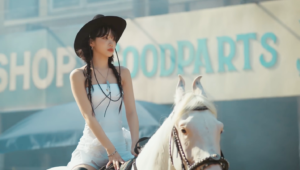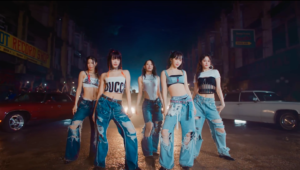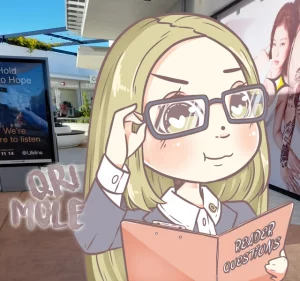
Ah, the third title track: the one that locks in the tone of a group. With the debut single, it’s all about blasting out of the gate, being as distinctive and impressive as possible (look to Itzy or IVE for stellar examples of this). By the second time around, there’s a choice: do something as similar as possible (a la Momoland), or swerve into as different a lane as you can (like Everglow).
Whichever route the group has chosen, the third major release will often solidify the trajectory that they have chosen to follow. In the case of Le Sserafim, their latest single, “Unforgiven”, confirms that they have found a style, and by god they’re sticking to it. Far from the experimentation of other 4th generation girl groups, Le Sserafim have chosen to stick with many of the same musical gimmicks, making for an underwhelming follow-up to their huge 2022 hit “Antifragile”. There are flashy (metaphorical) bells and whistles aplenty across the song and MV, but they do little to disguise that the group’s formula is not as fresh the third time around.
Perhaps the flashiest elements of all are the two star names attached to this song, and they are really big—Nile Rodgers and Ennio Morricone. The former is about as legendary as American musicians get, and this is his first collaboration with a K-pop group. It’s a really exciting premise: Rodgers has collaborated with the likes of Beyoncé and Daft Punk in the past, and his signature guitar is always a welcome addition. “Unforgiven” is, stylistically, a sort of hip-hop funk fusion, so everything is lining up to be amazing.
Except, where exactly is the Nile Rodgers contribution? With his name so prominent in the promotion for the song, you would expect it to be really clear where we can hear him. But, throughout the entire track, it’s hard to pin down where his influence really is at all. From Rodgers we expect disco, funk, great pop, but that isn’t the angle aimed for here at all.
Instead, the song and MV have leaned far more heavily into the Ennio Morricone sample from The Good, The Bad and The Ugly, for which they received permission from Ennio’s son to use. The iconic whistle from one of the most famous westerns in the world plays underneath twanging steel guitars across the verses and the chorus. Short as this sample is, its power alone adds atmosphere that is emphasised by the guitars, while being minimal enough not to override anything. It’s the best musical touch of the whole track, but it still leaves the mystery of exactly where they used Nile Rodgers. For the guitars? For the arrangement? It is unclear.

If you thought that, maybe, the disco or funk elements would find a more visual home in this MV, think again. Harkening back (a lot) to Itzy’s “Not Shy” and Oh My Girl’s “Nonstop”, there are multiple country stylings on show here. Most of these come through the fashion choices: we have Chaewon in a Stetson, on a horse, Kazuha in chaps and a bandana, Eunchae and Yunjin in black fringe, and the latter also sporting a frilled, layered pink dress that could have come out of a saloon. It’s not subtle (and neither is using the name of an Oscar-winning 1992 western), but it could be great fun. If it were a little more consistent.
This is because, alongside this musical and sartorial homage, the MV also decides to throw in other styles and scenarios that dilute any impact that this Western flavouring could bring. Some of these scenarios are exciting or eye-catching—Sakura’s sword-wielding scene, shot partly from the viewpoint of the sword itself, is a standout. So is Kazuha’s scene in a white minidress, flanked by huge swathes of white fabric attached to her back.
But other scenes miss the mark. Whilst Kazuha’s dress scene is bold and minimal, her earlier scene with actual flaming angel wings feels too literal. As she snaps off a burning wing and throws it behind her, the music temporarily stops, to make sure that we’ve noticed the metaphor. Yes, it is always nice to see the lore and the name of a group tied in to the visuals, but it feels so out of place here.

So too do many of Eunchae’s solo scenes, seeing her playing around with a cake or walking down a gothic hallway in a schoolgirl-esque outfit, complete with those ridiculous plastic boots that went viral earlier this year, but in black. If they have made the choice to lean into western themes, why waver?
The imagery of the angel and the schoolgirl may be to play with ideas of innocence in a song where the main refrain is “Unforgiven/I’m a villain”. The members have spoken about the song as embracing the fact that they will be judged, and celebrating moving beyond it.
I was powerless, used to lose every fight but I ride
Never asked for forgiveness or anything
Gonna target taboos, watch me now, now, now, now
However, the symbolism is confused at best, given that angelic imagery isn’t exactly evocative of the forbidden. Maybe something more devilish would have been appropriate for “targeting taboos”?

This notion of playing with, or even breaking the rules comes closest to fruition through the dramatic cinematography. Far from the clichéd moment that Yunjin steps out of a long dress and into a mini version, the MV is actually the most daring through its camera work. The opening gives us a swooping, zoomed-in tracking shot that takes us from outside a building, inside a restaurant and right up to Kazuha’s face.
Later, we are on the back of an arrow Yunjin shoots into the sky, following it as it zooms through the sky and into a warehouse. We also get to see her performing in the back of a car through a fish-eye lens. These are the moments that feel innovative and exciting, though they don’t seem to connect to any greater theme.
And what a missed opportunity for a theme it is. Villainy has so much fun, camp potential, but here it seems to be expressed mostly through one set of black outfits. Aside from this, there are a surprising number of similarities to “Antifragile” in the MV instead. From the baggy denim trousers and crop top combination that constitutes the second group outfit, to very similar choreography (arms spinning at the side of the waist, members forming a diagonal line, and ninety-degree bends all feature here too) and, of course, a chorus repeating the song’s title ad nauseum, “Unforgiven” feels like a bit of a repeat.

The final crowd scene of the MV does a little work to differentiate this song from its big sister, as this is definitely the most people featured in a Le Sserafim MV. This is a nice mirroring of the group’s callout to their listeners in the chorus.
Come to that faraway land with me, my unforgiven girls
Come and cross the line with me, my unforgiven boys
However, given that this crowd is pretty much just a backdrop, it ultimately makes minimal difference. They cannot disguise how familiar the final set piece feels, and the choreography and styling only compounds this.
Ultimately, in “Unforgiven”, it feels as though Le Sserafim have simply tried to yeehaw-ify the formula that worked well for their first two songs. They are more minimalist as a K-pop group, so the repetitive lyrics and uncomplicated styling make sense in isolation. However, when lining up their discography, the similarities just become too glaring.

The hook-heavy chorus is relying on the Morricone and guitar to make it work, all the while under-using the talent that Nile Rodgers can always bring. With all the potential that the idea of a villain can bring, especially in combination with the angelic symbolism inherent to the group, “Unforgiven” is underwhelming. Let’s hope that, as they continue to build up their work, they can really start to stray away from what they know.
(Youtube, Korea Herald, Vogue. Images via HYBE. Lyrics via Genius.)




